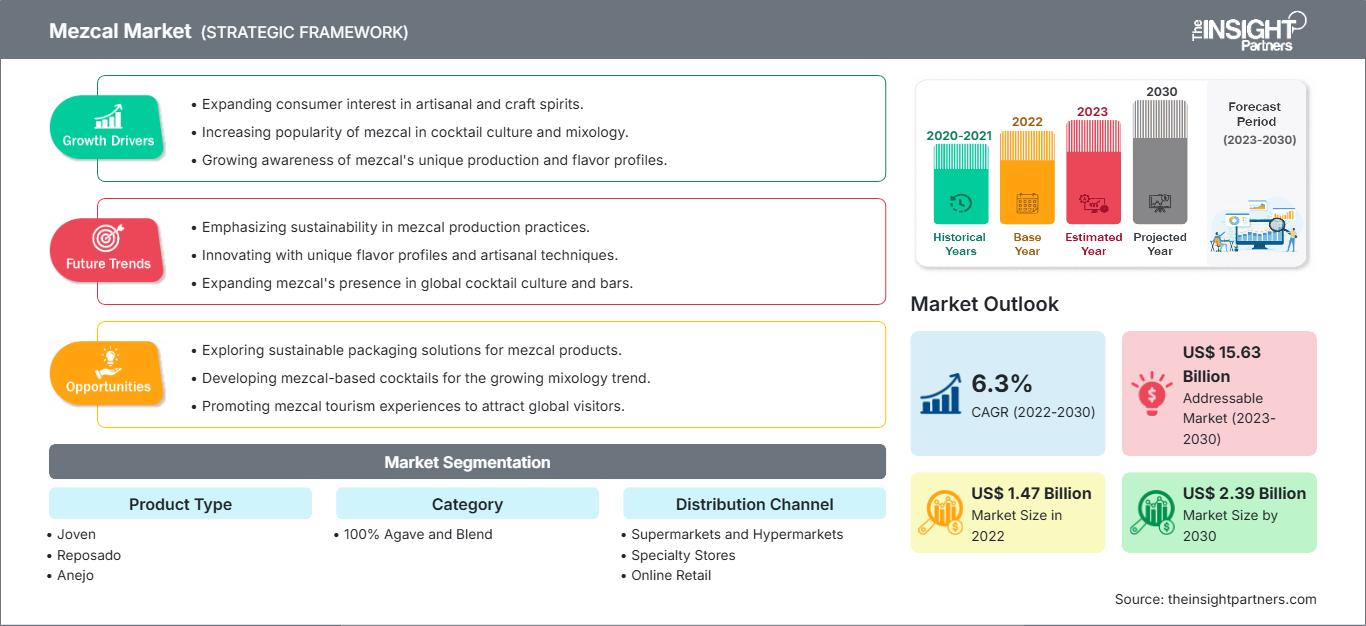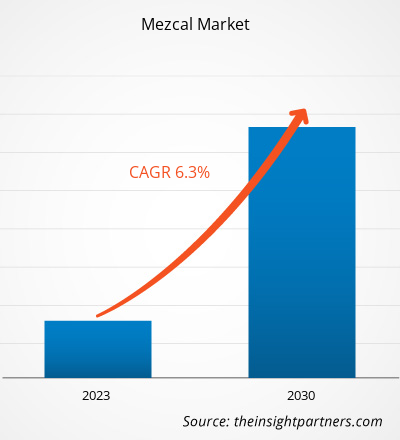2022 年,梅斯卡尔酒市场规模为 14.6917 亿美元,预计到 2030 年将达到 23.9357 亿美元;预计 2022 年至 2030 年的复合年增长率为 6.3%。
市场洞察和分析师观点
梅斯卡尔酒是一种独特的墨西哥烈酒,由龙舌兰植物制成,主要产于瓦哈卡地区。与完全由蓝色龙舌兰制成的梅斯卡尔酒——龙舌兰酒不同,梅斯卡尔酒可以用各种龙舌兰品种酿造,从而拥有更广泛的风味和香气。梅斯卡尔酒需求的激增可以归因于其手工制作的方法、独特的烟熏风味以及人们对手工烈酒日益增长的欣赏。消费者越来越追求饮酒体验的真实性和多样性,这使得梅斯卡尔酒在喜欢冒险的烈酒爱好者和调酒师中越来越受欢迎。它的文化遗产和传统的生产技术也增加了它的吸引力,使其成为那些想要探索丰富的龙舌兰烈酒世界的人的热门选择。增长动力和挑战
对奢侈和高端饮料的需求不断增长已成为梅斯卡尔酒的驱动力。这一趋势的一个重要催化剂是消费者可支配收入的增加。随着人们收入的增长,他们更倾向于将一部分预算用于享受梅斯卡尔酒等高端烈酒。这为高端梅斯卡尔酒品牌的蓬勃发展提供了机会,因为消费者正在寻求独特、高级的饮酒体验。此外,千禧一代的影响力也不容小觑。这个人口群体对高端饮料表现出特别的偏好,因为他们渴望品质、真实性和独特的风味。梅斯卡尔酒完全符合这些偏好,它提供的手工制作的手工制品引起了千禧一代的共鸣,极大地促进了需求的激增。
自定义此报告以满足您的要求
您将免费获得任何报告的定制,包括本报告的部分内容,或国家级分析、Excel 数据包,以及为初创企业和大学提供超值优惠和折扣
梅斯卡尔市场: 战略洞察

- 获取本报告的主要市场趋势。这个免费样本将包括数据分析,从市场趋势到估计和预测。
消费者偏好的演变在推动梅斯卡尔酒市场发展方面发挥着关键作用。现代消费者越来越追求独特而精致的烈酒,超越普通的混合酒。梅斯卡尔酒凭借其复杂的生产工艺、烟熏气息和独特的风味,完美契合了这一转变。它已成为高雅品味的象征,并赢得了高端饮品的美誉,吸引着那些寻求更高品位饮酒体验的眼光独到的消费者。蓬勃发展的鸡尾酒文化推动了梅斯卡尔酒在高端饮品市场的崛起。调酒师和调酒师将梅斯卡尔酒视为调制独特创新鸡尾酒的多功能高端原料。其烟熏和复杂的风味为饮品增添了深度和个性,使其成为高档酒吧和餐厅的热门之选。这提升了梅斯卡尔酒的知名度,并激发了消费者在家中重现这种高端鸡尾酒体验的兴趣,进一步推动了需求。您将免费获得任何报告的定制,包括本报告的部分内容,或国家级分析、Excel 数据包,以及为初创企业和大学提供超值优惠和折扣
梅斯卡尔市场: 战略洞察

- 获取本报告的主要市场趋势。这个免费样本将包括数据分析,从市场趋势到估计和预测。
有效的营销策略和独特的包装增强了梅斯卡尔酒作为奢侈品的认知度。高端梅斯卡尔酒品牌纷纷投入精良的品牌推广,以突出产品的手工酿造起源,彰显其独特性。这种营销策略吸引了那些寻求身份象征和独特礼品的消费者,从而增强了梅斯卡尔酒在高端烈酒市场的需求。此外,全球对正宗、精酿和传承产品的兴趣日益浓厚,也为梅斯卡尔酒带来了利好。消费者——尤其是千禧一代和Z世代——在购买决策中更加重视可追溯性、手工工艺和可持续性。梅斯卡尔酒的小批量生产、根深蒂固的文化传承以及与当地龙舌兰种植社区的紧密联系,使其成为一款能够引起注重道德的消费者共鸣的烈酒。因此,它不仅是一种高端饮品,更代表着一种以文化欣赏和理性消费为中心的生活方式选择。
梅斯卡尔酒在国际市场上的影响力日益增强,这得益于其分销渠道的不断拓展以及参与全球烈酒展览和比赛的日益增多,这持续提升了品牌知名度,并巩固了其高端形象。因此,消费者偏好的动态变化是梅斯卡尔酒市场增长的关键催化剂。
然而,墨西哥对梅斯卡尔酒的生产、标签和认证有着严格的监管规定。梅斯卡尔酒原产地名称保护了梅斯卡尔酒的地理来源和传统生产方法,并制定了一系列可能对生产商造成负担的规则。例如,要贴上“梅斯卡尔”的标签,烈酒必须由特定品种的龙舌兰酿造而成,这些龙舌兰主要生长在墨西哥的某些地区,并使用传统方法酿造。传统方法包括在土坑或粘土炉中烹制、手工研磨、在石坑或有机坑中发酵,以及在铜罐或陶罐下用明火蒸馏。满足这些要求可能成本高昂或耗时,从而限制了小型生产商进入市场并有效竞争的能力。
另一个监管挑战与认证和标签有关。生产商必须遵守严格的质量标准并经过认证流程才能获得官方的“梅斯卡尔”标签。这对于规模较小的本地生产商来说可能是一个障碍,因为他们可能没有足够的资源来处理这些官僚程序或投资必要的设备和设施。此外,关于标签和广告的严格规定包括明确说明所用的龙舌兰种类、产地和蒸馏工艺。任何违反这些规定的行为都可能导致法律问题,因此生产商必须严格遵守。这些监管限制可能会限制市场准入、阻碍创新并增加合规成本,尤其是对于小型梅斯卡尔生产商而言。
报告细分和范围
全球梅斯卡尔酒市场根据产品类型、类别、分销渠道和地域进行细分。根据产品类型,市场分为年轻型、雷普萨多型、安尼霍型和其他型。按类别,市场分为 100% 龙舌兰酒和混合型。按分销渠道,市场分为超市和大卖场、专卖店、在线零售和其他。按地域划分,全球梅斯卡尔酒市场大致分为北美、欧洲、亚太地区、中东和非洲以及南美和中美洲。细分分析
根据产品类型,市场分为年轻型、雷普萨多型、安尼霍型和其他型。预计雷普萨多细分市场在 2022 年至 2030 年期间的复合年增长率最高。 Reposado 在西班牙语中意为“静置”,它介于 Joven 的青春活力与 anejo 的陈年复杂之间。Reposado 梅斯卡尔酒在橡木桶中陈酿的时间相对较短,通常为两个月到一年。陈酿过程赋予了它更醇厚的口感,抚平了龙舌兰酒的一些尖锐边缘。Reposado 梅斯卡尔酒在保留了龙舌兰酒核心风味的同时,还增添了一些额外的风味,例如淡淡的香草、焦糖和木香。Reposado 梅斯卡尔酒的需求激增,得益于它能够平衡 Joven 未陈酿的活力与 anejo 的精致复杂,使其成为追求更顺滑、更易接受的梅斯卡尔酒体验的人士的首选。区域分析
梅斯卡尔酒市场主要分为五个区域:北美、欧洲、亚太地区、南美和中美以及中东和非洲。北美主导着全球梅斯卡尔酒市场,2022年该地区市场规模达6.122亿美元。欧洲是第二大市场贡献者,占据全球市场29%以上的份额。预计亚太地区在2022年至2030年期间的复合年增长率将超过7%。梅斯卡尔酒在中国、印度、日本和澳大利亚等亚洲国家越来越受欢迎。消费者转向梅斯卡尔酒的主要原因是人们越来越关注健康问题。人们对高档酒精饮料的偏好日益增长,也增加了对梅斯卡尔酒的需求,预计这将推动亚太地区市场的增长。梅斯卡尔酒市场梅斯卡尔市场
The Insight Partners 的分析师已详尽阐述了预测期内影响梅斯卡尔酒市场的区域趋势和因素。本节还讨论了北美、欧洲、亚太地区、中东和非洲以及南美和中美洲的梅斯卡尔酒市场细分和地域分布。
梅斯卡尔市场报告范围
| 报告属性 | 细节 |
|---|---|
| 市场规模 2022 | US$ 1.47 Billion |
| 市场规模 2030 | US$ 2.39 Billion |
| 全球复合年增长率 (2022 - 2030) | 6.3% |
| 历史数据 | 2020-2021 |
| 预测期 | 2023-2030 |
| 涵盖的领域 |
By 产品类型
|
| 覆盖地区和国家 | 北美
|
| 市场领导者和主要公司简介 |
|
梅斯卡尔酒市场参与者密度:了解其对商业动态的影响
梅斯卡尔酒市场正在快速增长,这得益于终端用户需求的不断增长,而这些需求的驱动因素包括消费者偏好的演变、技术进步以及对产品优势的认知度不断提高。随着需求的增长,各企业正在拓展产品线,不断创新以满足消费者需求,并抓住新兴趋势,从而进一步推动市场增长。

- 获取 梅斯卡尔市场 主要参与者概述
竞争格局和主要公司
Casa Agave Ltd、Quiquiriqui Mezcal Ltd、Davide Campari Milano NV、Gente de Mezcal SA de CV、Bacardi-Martini BV、Diageo Plc、Pernod Ricard SA、Meanwhile Drinks Ltd、Proximo Spirits Inc 和 Madre Mezcal Inc 是全球梅斯卡尔酒市场上的主要参与者。- 历史分析(2 年)、基准年、预测(7 年)及复合年增长率
- PEST和SWOT分析
- 市场规模、价值/数量 - 全球、区域、国家
- 行业和竞争格局
- Excel 数据集
近期报告
客户评价
购买理由
- 明智的决策
- 了解市场动态
- 竞争分析
- 客户洞察
- 市场预测
- 风险规避
- 战略规划
- 投资论证
- 识别新兴市场
- 优化营销策略
- 提升运营效率
- 顺应监管趋势




















 获取免费样品 - 梅斯卡尔市场
获取免费样品 - 梅斯卡尔市场